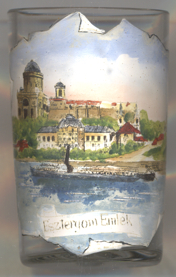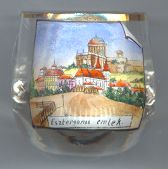

|
| MAGYARORSZÁG | HUNGARY |
| megye: Komárom-Esztergom |
Esztergom is situated at an elevation of 261 m on the right bank of the river Danube, the border to Slovakia. During Roman times called Strigonium, Esztergom became the first royal seat of Hungary when Prince Géza chose it as his seat. His son, Saint Stephen (István I), who was also born here in 975, was crowned here as the first king of Hungary in 1000. Since 1198 Esztergom is also the seat of the archprimate of Hungary. Until the 13th century it remained the capital of the country. In 1241 it was sacked by the Mongols and during much of the 16th and 17th centuries it was occupied by the Turks. Today it is still the ecclesiastical centre of Hungary. Situated in the centre of an extensive vineyard region, Esztergom carries on trade in wine and grain. Its mineral springs also make it popular with tourists. In 1923 the counties of Esztergom and Komárom were merged into the new county Komárom-Esztergom. However, in 1937, the two counties were re-established. Only one year later, in 1938, the counties were merged again under the name Komárom-Esztergom; the county seat, however, is in Tatabánya.

 Dominating on a hill above the city is the
Dominating on a hill above the city is the  cathedral of Esztergom.
The church was rebuilt in Neo-Gothic style in the 19th century and is the largest church in Hungary
(118 m long, 40 m wide, its characteristic dome has a height of 100 m, internal height 72 m).
On the occasion of the consecration of the new church in 1869 Franz (Ferenc) Liszt composed and conducted his famous Gran mass (Graner Messe).
The cathedral also incorporates the Bakócz chapel, constructed in red marble in 1506–1508 by Cardinal Tamás Bakócz.
It is the most important Renaissance chapel in the country.
The treasury of the church includes numerous objects and relics, among them the calvary of King Matthias Corvinus (king 1458–1490).
cathedral of Esztergom.
The church was rebuilt in Neo-Gothic style in the 19th century and is the largest church in Hungary
(118 m long, 40 m wide, its characteristic dome has a height of 100 m, internal height 72 m).
On the occasion of the consecration of the new church in 1869 Franz (Ferenc) Liszt composed and conducted his famous Gran mass (Graner Messe).
The cathedral also incorporates the Bakócz chapel, constructed in red marble in 1506–1508 by Cardinal Tamás Bakócz.
It is the most important Renaissance chapel in the country.
The treasury of the church includes numerous objects and relics, among them the calvary of King Matthias Corvinus (king 1458–1490).
Cardinal József Mindszenty, appointed Archbishop of Esztergom in 1945 and cardinal in 1946, was arrested and sentenced to life-imprisonment in 1948/49 by the communist rulers of Hungary. He was released in 1956 but had to seek asylum in the American embassy. In 1971 he emigrated to Austria. After his death in 1975 he was buried in the basilica of Mariazell. In 1991 his remains were brought home to the cathedral of Esztergom.
Shown also in the picture on glass no. 3083 [left] is the Catholic
 church
church
Depicted to the left of the church of St. Ignatius is the
 Primate's
Primate's
[http://salviatimosaics.blogspot.co.at/2013/08/prince-primates-palace-esztergom.html,
http://www.hungary-tourist-guide.com/esztergom.html,
http://visitbudapest.travel/activities/budapest-vicinity/esztergom/]
![[scale]](lineal.jpg)